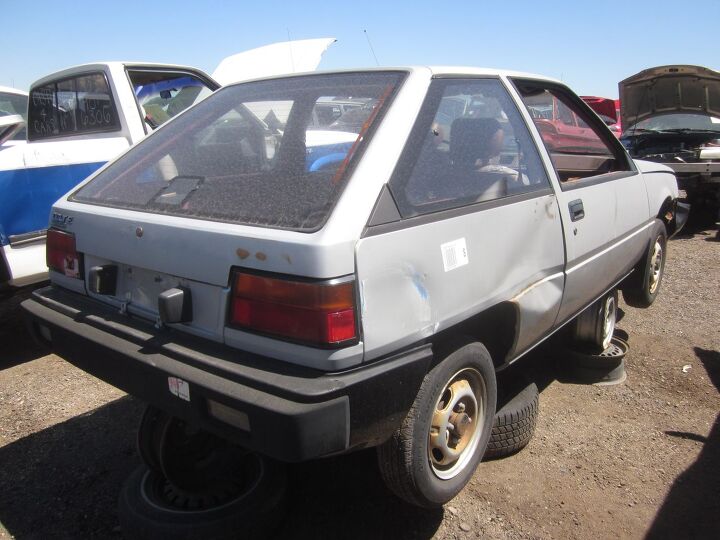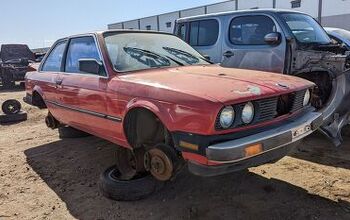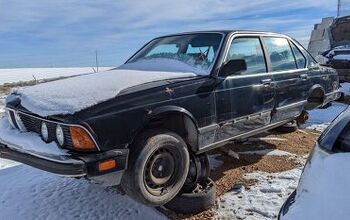Junkyard Find: 1986 Plymouth Colt

Chrysler spent a couple of decades selling Mitsubishis and Simcas with Dodge and Plymouth badges in North America, and the Mitsubishi Galant/Lancer-based Colt line went through the most twists and turns. At first, Plymouth-branded Colts were sold as Champs, but by the mid-1980s both the Dodge and Plymouth versions were called Colts. The difference? Damn if I can find one that goes deeper than emblems.
Imported for Plymouth! This generation of Colt has become quite rare on the street, though they seemed as common as Corollas and Civics when new.
While Japanese econoboxes of the 1980s were mostly pretty miserable machines, I do sometimes miss their weird, vaguely science-fiction-ish interiors. And remember when cars had interior space not completely used up by cockpit-style consoles and cup holders?
This is the bread-and-butter, non-turbo, non-Twin-Stick Colt, complete with 4G15 Orion engine. The Colt of this era wasn’t much known for reliability, but it was cheap and sipped gas. The entry-level Colt E two-door hatch listed at $5,372, or about 300 bucks cheaper than a new Chevette. The ’86 Subaru STD (yes, there was a car called the STD) could be purchased for $4,989, and the bottom-of-the-barrel ’86 Excel went for $4,995. The Colt was a far superior vehicle to the Chevette, STD, and Excel, and so was a pretty good deal at the time (though the much better Civic two-door hatch was just a C-note more expensive).
And now almost all of them are gone. I’d like to think that a few Colts of this vintage will stay with us, though I’m certainly not willing to rescue one myself.

Murilee Martin is the pen name of Phil Greden, a writer who has lived in Minnesota, California, Georgia and (now) Colorado. He has toiled at copywriting, technical writing, junkmail writing, fiction writing and now automotive writing. He has owned many terrible vehicles and some good ones. He spends a great deal of time in self-service junkyards. These days, he writes for publications including Autoweek, Autoblog, Hagerty, The Truth About Cars and Capital One.
More by Murilee Martin
Latest Car Reviews
Read moreLatest Product Reviews
Read moreRecent Comments
- MaintenanceCosts Nobody here seems to acknowledge that there are multiple use cases for cars.Some people spend all their time driving all over the country and need every mile and minute of time savings. ICE cars are better for them right now.Some people only drive locally and fly when they travel. For them, there's probably a range number that works, and they don't really need more. For the uses for which we use our EV, that would be around 150 miles. The other thing about a low range requirement is it can make 120V charging viable. If you don't drive more than an average of about 40 miles/day, you can probably get enough electrons through a wall outlet. We spent over two years charging our Bolt only through 120V, while our house was getting rebuilt, and never had an issue.Those are extremes. There are all sorts of use cases in between, which probably represent the majority of drivers. For some users, what's needed is more range. But I think for most users, what's needed is better charging. Retrofit apartment garages like Tim's with 240V outlets at every spot. Install more L3 chargers in supermarket parking lots and alongside gas stations. Make chargers that work like Tesla Superchargers as ubiquitous as gas stations, and EV charging will not be an issue for most users.
- MaintenanceCosts I don't have an opinion on whether any one plant unionizing is the right answer, but the employees sure need to have the right to organize. Unions or the credible threat of unionization are the only thing, history has proven, that can keep employers honest. Without it, we've seen over and over, the employers have complete power over the workers and feel free to exploit the workers however they see fit. (And don't tell me "oh, the workers can just leave" - in an oligopolistic industry, working conditions quickly converge, and there's not another employer right around the corner.)
- Kjhkjlhkjhkljh kljhjkhjklhkjh [h3]Wake me up when it is a 1989 635Csi with a M88/3[/h3]
- BrandX "I can charge using the 240V outlets, sure, but it’s slow."No it's not. That's what all home chargers use - 240V.
- Jalop1991 does the odometer represent itself in an analog fashion? Will the numbers roll slowly and stop wherever, or do they just blink to the next number like any old boring modern car?













































Comments
Join the conversation
My grandmother had this EXACT Colt until she traded it for a Cutlass Ciera in 1993. It was light brown and had an automatic, but it was a hatchback. She frickin' LOVED that little car...it was dead reliable and great on gas in a way that modern cars can only envy. The funniest thing is that my grandmother, who grew up in WW2 with stories of Japanese atrocity, didn't realize what she was driving was actually an Asian import. And at the time I remember what a vocal critic she was of people driving those "lil' old tin-can Toyotas." She swears to this day she didn't know it wasn't domestic, although after the Ciera died this past year she immediately went out and got a 2012 Toyota Corolla. People change, LOL. The Colt is still her favorite car of all she ever owned.
I live in Guatemala Central America and I have one of those beauties, It's been a headache to get all the accessories and car parts.
My dream is to restore it as if it would be brand new.